Chillers Size
Chillers Market Growth Projections and Opportunities
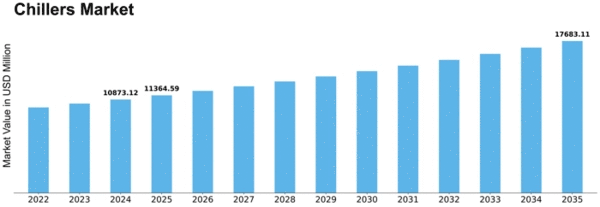
Searching...


How much is the Chillers Market?
The Chillers Market size is expected to be valued at USD 15,374.0 Million in 2032.
What is the growth rate of the Chillers Market?
The global market is projected to grow at a CAGR of 4.5% during the forecast period, 2024-2032.
Which region held the largest market share in the Chillers Market?
Asia-Pacific had the largest share of the global market.
Who are the key players in the Chillers Market?
The key players in the market are Carrier Global Corporation, DAIKIN INDUSTRIES LTD, MITSUBISHI ELECTRIC CORPORATION, DIMPLEX THERMAL SOLUTIONS, LG Electronics, JOHNSON CONTROLS INTERNATIONAL PLC, Polyscience Inc, SMARDT CHILLER GROUP INC, THERMAX LTD., TRANE Technologies Plc, and others.
Which Product Type led the Chillers Market?
The Water-Cooled Chiller category dominated the market in 2023.
Which End User had the largest market share in the Chillers Market?
The others segment had the largest revenue share of the global market.
As per Market Research Future analysis, the Chillers Market Size was estimated at 10873.12 USD Million in 2024. The Chillers industry is projected to grow from USD 11364.61 Million in 2025 to USD 17683.11 Million by 2035, exhibiting a compound annual growth rate (CAGR) of 4.5% during the forecast period 2025 - 2035
The Chillers Market is currently experiencing a dynamic shift towards sustainability and technological integration.
| 2024 Market Size | 10873.12 (USD Million) |
| 2035 Market Size | 17683.11 (USD Million) |
| CAGR (2025 - 2035) | 4.52% |
| Largest Regional Market Share in 2024 | North America |
<p><a href="https://www.carrier.com/commercial/en/in/products/commercial-products/chillers/">Carrier </a>(US), Trane Technologies (IE), Daikin Industries (JP), Johnson Controls (US), <a href="https://les.mitsubishielectric.co.uk/products/commercial-heat-pumps-and-chillers/chillers">Mitsubishi Electric</a> (JP), Lennox International (US), York International (US), Gree Electric Appliances (CN), Haier Group (CN)</p>
The Chillers Market is currently experiencing a dynamic evolution, driven by various factors including technological advancements and increasing energy efficiency demands. As industries strive to reduce their carbon footprints, the adoption of eco-friendly refrigerants and innovative cooling solutions appears to be gaining traction. This shift not only aligns with global sustainability goals but also enhances operational efficiency across multiple sectors, including commercial, industrial, and residential applications. Furthermore, the growing emphasis on smart technologies and automation in HVAC systems suggests a potential transformation in how chillers are integrated into existing infrastructures. In addition, the Chillers Market is likely to witness a surge in demand due to the rising need for temperature control in various applications, such as food and beverage processing, pharmaceuticals, and data centers. The increasing urbanization and expansion of infrastructure projects may further contribute to this trend, as more facilities require reliable cooling systems. Overall, the Chillers Market seems poised for growth, with opportunities emerging from both technological innovations and evolving consumer preferences.
The Chillers Market is increasingly influenced by sustainability initiatives, as businesses seek to minimize their environmental impact. This trend is characterized by the adoption of energy-efficient chillers and the use of natural refrigerants, which are less harmful to the ozone layer. Companies are likely to invest in technologies that not only comply with regulations but also enhance their corporate social responsibility profiles.
The integration of smart technologies into the Chillers Market is becoming more prevalent. This trend involves the use of IoT devices and advanced monitoring systems that allow for real-time data analysis and predictive maintenance. Such innovations can lead to improved energy management and operational efficiency, making chillers more responsive to changing demands.
Emerging markets are showing a growing appetite for advanced cooling solutions, which is expected to drive the Chillers Market forward. As these regions develop their infrastructure and industrial capabilities, the demand for reliable and efficient cooling systems is likely to increase. This expansion presents opportunities for manufacturers to cater to diverse needs and preferences.
The Global Chillers Market Industry is experiencing a notable shift towards energy-efficient solutions. As energy costs continue to rise, businesses are increasingly seeking chillers that minimize energy consumption while maximizing cooling output. This trend is reflected in the projected market value of 10.9 USD Billion in 2024, driven by regulations promoting energy efficiency. Governments worldwide are implementing stringent energy efficiency standards, compelling manufacturers to innovate and produce advanced chillers that meet these requirements. Consequently, the demand for energy-efficient chillers is expected to grow, contributing to the overall expansion of the Global Chillers Market Industry.
The food and beverage sector is a critical driver of the Global Chillers Market Industry. With the increasing demand for processed and packaged foods, the need for efficient cooling towers in production and storage facilities is paramount. Chillers Market play a vital role in maintaining product quality and safety, particularly in temperature-sensitive items. As the global population continues to grow, the food and beverage industry is expected to expand, further driving the demand for chillers. This trend is likely to contribute to the overall market growth, with projections indicating a market value of 17.5 USD Billion by 2035, underscoring the significance of this sector in the Global Chillers Market Industry.
The Global Chillers Market Industry is significantly influenced by the ongoing trends of industrialization and urbanization. As urban areas expand and industries proliferate, the demand for effective cooling solutions rises correspondingly. This is particularly evident in developing regions where rapid urban growth necessitates robust infrastructure, including HVAC systems. The increasing number of commercial buildings and manufacturing facilities is expected to drive the market, with a projected CAGR of 4.45% from 2025 to 2035. This growth trajectory highlights the essential role of chillers in supporting the cooling needs of burgeoning urban centers, thereby reinforcing the Global Chillers Market Industry.
Technological innovation plays a pivotal role in shaping the Global Chillers Market Industry. The introduction of smart chillers equipped with IoT capabilities allows for real-time monitoring and optimization of cooling processes. These advancements not only enhance operational efficiency but also reduce maintenance costs. For instance, predictive maintenance technologies can identify potential failures before they occur, thereby minimizing downtime. As these technologies become more prevalent, they are likely to attract investments, further propelling the market. The anticipated growth in the market, reaching 17.5 USD Billion by 2035, underscores the importance of technological advancements in driving the Global Chillers Market Industry.
Regulatory frameworks promoting environmental sustainability are increasingly shaping the Global Chillers Market Industry. Governments are enacting policies aimed at reducing greenhouse gas emissions, which directly impacts the types of refrigerants used in chillers. The shift towards low-GWP (Global Warming Potential) refrigerants is becoming a standard requirement, compelling manufacturers to adapt their products accordingly. This regulatory support not only fosters innovation but also enhances market competitiveness. As the industry aligns with these environmental standards, it is likely to witness sustained growth, contributing to the projected market value of 10.9 USD Billion in 2024 and beyond.
<p>The Chillers Market shows a diverse application landscape, primarily segmented into Commercial Cooling, Industrial Cooling, Process Cooling, and Residential Cooling. Commercial Cooling holds the largest share due to the rising demand for efficient cooling solutions in retail, hotels, and office buildings. Conversely, Industrial Cooling and Process <a href="https://www.marketresearchfuture.com/reports/cooling-towers-market-12009">Cooling towers</a> are also significant, catering to manufacturing and chemical processes, respectively, but at a lesser market stake. Meanwhile, Residential Cooling, while smaller, remains crucial in the market spectrum as homeowners increasingly seek energy-efficient solutions for better comfort.</p>
<p>Commercial Cooling (Dominant) vs. Process Cooling (Emerging)</p>
<p>Commercial Cooling dominates the Chillers Market, driven by the increasing need for reliable cooling in commercial establishments such as shopping malls, hospitals, and educational institutions. This segment benefits from advancements in energy-efficient technologies and regulatory support encouraging green solutions. On the other hand, Process Cooling is emerging as a vital segment, especially in industries requiring precise temperature controls, such as pharmaceuticals and food production. With the growth of industrial automation and the complexity of processes, the demand for efficient process cooling systems is rising rapidly, marking it as an area of significant growth potential in the Chillers Market.</p>
<p>In the Chillers Market, the end use segment is characterized by significant distribution across various industries. The Food and Beverage sector holds the largest share of the market, benefiting from the growing demand for chilled storage solutions to ensure product quality and freshness. Following closely is the Pharmaceuticals sector, which, while smaller in terms of market share, is rapidly growing as the need for temperature-controlled environments for drugs and vaccines becomes increasingly critical in healthcare settings. The growth trends for the end use segment are primarily driven by advancements in technology and an increasing awareness of the importance of temperature control in preserving the integrity of products. The Food and Beverage industry continues to expand with rising consumer preferences for fresh and frozen products, while the Pharmaceuticals sector is propelled by an ageing population and the global response to health emergencies requiring efficient storage solutions. As such, both segments are expected to contribute significantly to the overall growth of the Chillers Market.</p>
<p>Food and Beverage (Dominant) vs. Pharmaceuticals (Emerging)</p>
<p>The Food and Beverage segment remains the dominant force in the Chillers Market, characterized by its critical role in maintaining product quality and safety. This sector encompasses a wide range of applications, from large-scale storage in distribution centers to point-of-sale refrigeration in supermarkets and restaurants. The adoption of innovative chilling technologies keeps pace with the evolving preferences of consumers for fresh products. Conversely, the Pharmaceuticals segment is marked as an emerging player, reflecting rapid expansion due to increasing demand for temperature-sensitive products, including biologics and vaccines. This segment is prioritizing compliance with stringent regulations and focusing on the development of advanced chillers that provide precise temperature control, ensuring the integrity of high-value medical products.</p>
<p>In the Chillers Market, Water-Cooled Chillers hold the largest market share due to their efficiency and suitability for large-scale operations. They are preferred in commercial and industrial facilities, driving their dominance. In contrast, Air-Cooled Chillers are gaining popularity, particularly in smaller installations and areas with water scarcity, which helps to propel their growth as a preferred alternative.</p>
<p>Water-Cooled Chillers (Dominant) vs. Absorption Chillers (Emerging)</p>
<p>Water-Cooled Chillers are characterized by their high efficiency, better cooling capacity, and ability to serve larger facilities, establishing them as the dominant force in this segment. On the other hand, <a href="https://www.marketresearchfuture.com/reports/absorption-chillers-market-25494">Absorption Chillers</a>, which utilize heat sources for cooling, are emerging due to their ability to utilize alternative energy sources and provide cost savings in specific applications. As sustainability becomes a priority, Absorption Chillers are positioning themselves to capture a larger share of the market through innovations and increased adoption in energy-conscious sectors.</p>
<p>In the Chillers Market, the distribution among differently sized cooling capacities showcases a diverse landscape. Large Capacity chillers dominate the market, appealing to industries that require extensive cooling solutions, while Medium Capacity units are emerging as a strong contender due to their versatility and range of applications. Small Capacity chillers, although present, serve niche segments and represent a smaller share overall. The vast requirements in industries like pharmaceuticals and food processing underscore the critical role of these larger chillers, maintaining a formidable market presence. As industries transition towards more energy-efficient and eco-friendly solutions, growth trends indicate a significant shift towards Medium Capacity chillers, which are designed to accommodate fluctuating cooling demands while optimizing energy usage. This segment is particularly driven by advancements in technology, with manufacturers focusing on smarter, more adaptive systems that cater to varying operational scales. Moreover, the increasing emphasis on sustainability in industrial practices further propels the demand for chillers that strike a balance between capacity and efficiency, marking Medium Capacity chillers as a rapidly expanding portion of the market.</p>
<p>Large Capacity (Dominant) vs. Medium Capacity (Emerging)</p>
<p>Large Capacity chillers are characterized by their robust ability to handle high thermal loads, making them essential in large-scale industrial applications like chemical processing, data centers, and manufacturing facilities. These units provide consistent and reliable cooling and are typically designed for long-term operation, ensuring maximum efficiency. On the other hand, Medium Capacity chillers are being recognized for their flexibility and adaptability, appealing to a broad range of mid-sized operations. Their development has been fueled by a growing demand for cooling solutions that can easily scale with business needs while minimizing energy consumption. As industries continue to seek efficiency and performance, both segments hold significant positions, with Large Capacity units maintaining dominance, while Medium Capacity units are poised for rapid growth.</p>
North America is poised to maintain its leadership in the chillers market, holding a significant share of 5450.0. The region's growth is driven by increasing demand for energy-efficient cooling solutions, stringent environmental regulations, and advancements in technology. The push for sustainable practices and the adoption of smart building technologies are further propelling market expansion. Regulatory incentives for energy efficiency are also catalyzing investments in modern chillers. The competitive landscape in North America is robust, featuring key players such as Carrier, Trane Technologies, and Johnson Controls. These companies are at the forefront of innovation, focusing on developing high-efficiency chillers that meet evolving consumer demands. The U.S. and Canada are the leading countries in this market, with a strong emphasis on retrofitting existing systems to enhance energy efficiency. The presence of established manufacturers ensures a dynamic market environment, fostering continuous improvement and competition.
Europe's chillers market is projected to reach 3500.0, driven by increasing urbanization and a growing focus on energy efficiency. The region is witnessing a shift towards environmentally friendly cooling solutions, supported by EU regulations aimed at reducing carbon emissions. The demand for chillers in commercial and industrial applications is on the rise, fueled by the need for reliable cooling systems in various sectors. Regulatory frameworks are encouraging investments in innovative technologies, enhancing market growth. Leading countries in Europe include Germany, France, and the UK, where major players like Trane Technologies and Daikin Industries are actively competing. The competitive landscape is characterized by a mix of established firms and emerging startups, all striving to innovate and capture market share. The presence of stringent regulations ensures that companies prioritize energy efficiency and sustainability in their product offerings. "The European market is increasingly focused on sustainable cooling solutions to meet regulatory demands," European Commission report states.
The Asia-Pacific chillers market, valued at 1500.0, is experiencing rapid growth, driven by urbanization and industrialization. Countries like China and India are witnessing a surge in demand for cooling solutions due to rising temperatures and increased construction activities. The region's focus on energy efficiency and sustainability is prompting investments in advanced chiller technologies. Government initiatives aimed at reducing energy consumption are also playing a crucial role in market expansion. China is the dominant player in the Asia-Pacific market, with significant contributions from local manufacturers such as Gree Electric Appliances and Haier Group. The competitive landscape is evolving, with both domestic and international players vying for market share. The increasing adoption of smart technologies in HVAC systems is further enhancing the growth prospects of the chillers market in this region. Companies are focusing on innovation to meet the diverse needs of consumers and comply with regulatory standards.
The Middle East and Africa chillers market, valued at 423.12, is emerging as a significant player in the global landscape. The region's growth is driven by increasing investments in infrastructure and a rising demand for cooling solutions in both residential and commercial sectors. The harsh climate conditions in many areas necessitate efficient cooling systems, leading to a surge in chiller installations. Regulatory frameworks are gradually evolving to support energy-efficient technologies, further boosting market potential. Countries like the UAE and South Africa are leading the market, with key players such as Johnson Controls and Mitsubishi Electric establishing a strong presence. The competitive landscape is characterized by a mix of global and regional companies, all striving to innovate and meet the growing demand. The focus on sustainability and energy efficiency is becoming increasingly important, as governments implement regulations to promote environmentally friendly practices. "The Middle East is witnessing a growing demand for energy-efficient cooling solutions," report from the Gulf Cooperation Council states.
The Chillers Market is currently characterized by a dynamic competitive landscape, driven by increasing demand for energy-efficient cooling solutions and stringent environmental regulations. Major players such as Carrier (US), Trane Technologies (IE), and Daikin Industries (JP) are at the forefront, each adopting distinct strategies to enhance their market positioning. Carrier (US) emphasizes innovation in energy-efficient technologies, while Trane Technologies (IE) focuses on sustainability and digital transformation. Daikin Industries (JP) is leveraging its global presence to expand its product offerings, particularly in the Asia-Pacific region, thereby shaping a competitive environment that prioritizes technological advancement and environmental responsibility.
Key business tactics within the Chillers Market include localizing manufacturing and optimizing supply chains to enhance operational efficiency. The market structure appears moderately fragmented, with a mix of established players and emerging companies. The collective influence of key players fosters a competitive atmosphere where innovation and customer-centric solutions are paramount, allowing companies to differentiate themselves in a crowded marketplace.
In November 2025, Carrier (US) announced the launch of its latest line of eco-friendly chillers, which utilize advanced refrigerants with lower global warming potential. This strategic move not only aligns with global sustainability goals but also positions Carrier as a leader in environmentally responsible cooling solutions. The introduction of these chillers is expected to enhance Carrier's market share, particularly among environmentally conscious consumers and businesses.
In October 2025, Trane Technologies (IE) unveiled a new digital platform designed to optimize energy management for commercial buildings. This platform integrates AI and IoT technologies, enabling real-time monitoring and predictive maintenance of chillers. The strategic importance of this initiative lies in its potential to reduce operational costs for clients while enhancing energy efficiency, thereby reinforcing Trane's commitment to sustainability and innovation in the Chillers Market.
In September 2025, Daikin Industries (JP) expanded its manufacturing capabilities in Southeast Asia, investing approximately $50 million in a new facility. This expansion is strategically significant as it allows Daikin to meet the growing demand for chillers in emerging markets, particularly in countries experiencing rapid urbanization. By localizing production, Daikin aims to reduce lead times and enhance its competitive edge in the region.
As of December 2025, current trends in the Chillers Market indicate a strong emphasis on digitalization, sustainability, and AI integration. Strategic alliances among key players are increasingly shaping the competitive landscape, fostering innovation and collaboration. The shift from price-based competition to a focus on technological advancement and supply chain reliability is evident, suggesting that future differentiation will hinge on the ability to deliver innovative, efficient, and sustainable solutions.
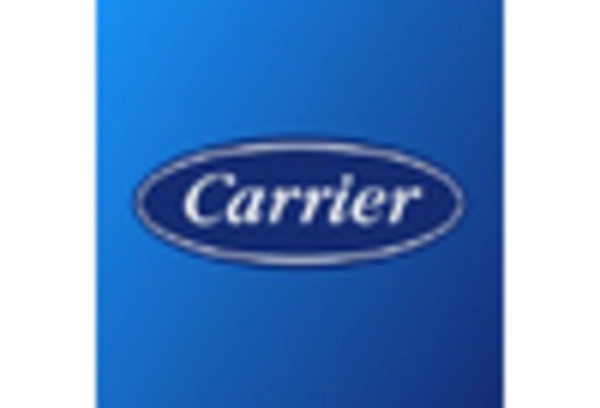
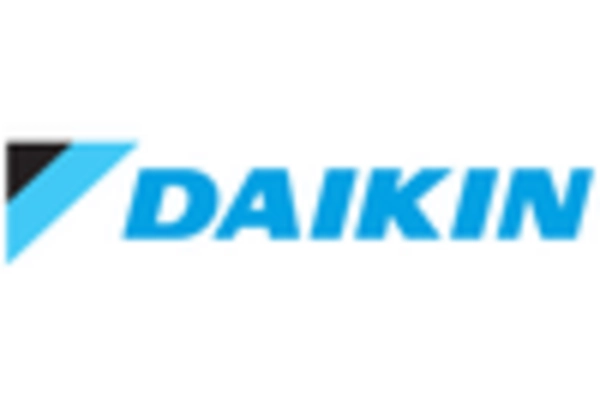

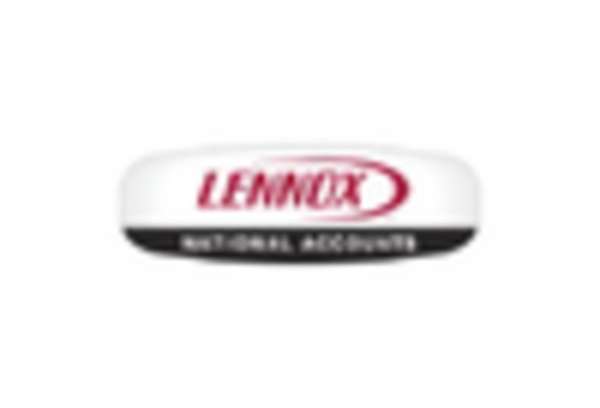
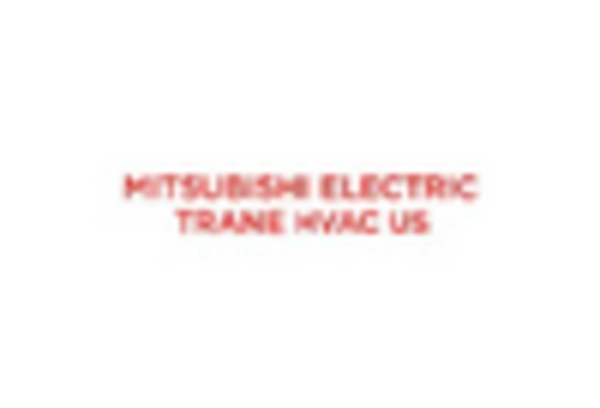

In April 2024, Mitsubishi Electric introduces MECH-iF, an air-cooled chiller range featuring proprietary single screw compressors for enhanced energy efficiency and reliability.
In March 2024, Carrier introduced a new line of high-performance chillers tailored for data centres, featuring energy-saving technology and resilient operation. The AquaForce 30XF air-cooled screw chillers offer up to 50% energy savings with integrated hydronic free-cooling systems.
In March 2024, Daikin Applied unveils the enhanced Navigator WWV water-cooled screw chiller with an integrated heat recovery configuration, featuring low-global warming potential refrigerant R-513A, enabling significant energy savings and bolstering sustainability efforts in HVAC solutions.
<p>The Chillers Market is projected to grow at a 4.52% CAGR from 2024 to 2035, driven by energy efficiency demands, technological advancements, and increasing cooling needs in various sectors.</p>
New opportunities lie in:
<p>By 2035, the Chillers Market is expected to achieve robust growth, driven by innovation and strategic market positioning.</p>
| MARKET SIZE 2024 | 10873.12(USD Million) |
| MARKET SIZE 2025 | 11364.61(USD Million) |
| MARKET SIZE 2035 | 17683.11(USD Million) |
| COMPOUND ANNUAL GROWTH RATE (CAGR) | 4.52% (2024 - 2035) |
| REPORT COVERAGE | Revenue Forecast, Competitive Landscape, Growth Factors, and Trends |
| BASE YEAR | 2024 |
| Market Forecast Period | 2025 - 2035 |
| Historical Data | 2019 - 2024 |
| Market Forecast Units | USD Million |
| Key Companies Profiled | Carrier (US), Trane Technologies (IE), Daikin Industries (JP), Johnson Controls (US), Mitsubishi Electric (JP), Lennox International (US), York International (US), Gree Electric Appliances (CN), Haier Group (CN) |
| Segments Covered | Application, End Use, Chiller Type, Cooling Capacity |
| Key Market Opportunities | Integration of energy-efficient technologies and smart controls in the Chillers Market presents substantial growth opportunities. |
| Key Market Dynamics | Rising demand for energy-efficient chillers drives technological advancements and competitive dynamics in the market. |
| Countries Covered | North America, Europe, APAC, South America, MEA |
How much is the Chillers Market?
The Chillers Market size is expected to be valued at USD 15,374.0 Million in 2032.
What is the growth rate of the Chillers Market?
The global market is projected to grow at a CAGR of 4.5% during the forecast period, 2024-2032.
Which region held the largest market share in the Chillers Market?
Asia-Pacific had the largest share of the global market.
Who are the key players in the Chillers Market?
The key players in the market are Carrier Global Corporation, DAIKIN INDUSTRIES LTD, MITSUBISHI ELECTRIC CORPORATION, DIMPLEX THERMAL SOLUTIONS, LG Electronics, JOHNSON CONTROLS INTERNATIONAL PLC, Polyscience Inc, SMARDT CHILLER GROUP INC, THERMAX LTD., TRANE Technologies Plc, and others.
Which Product Type led the Chillers Market?
The Water-Cooled Chiller category dominated the market in 2023.
Which End User had the largest market share in the Chillers Market?
The others segment had the largest revenue share of the global market.
Chillers Market Segmentation

Kindly complete the form below to receive a free sample of this Report

“This is really good guys. Excellent work on a tight deadline. I will continue to use you going forward and recommend you to others. Nice job”

“Thanks. It’s been a pleasure working with you, please use me as reference with any other Intel employees.”

“Thanks for sending the report it gives us a good global view of the Betaïne market.”

“Thank you, this will be very helpful for OQS.”

“We found the report very insightful! we found your research firm very helpful. I'm sending this email to secure our future business.”

“I am very pleased with how market segments have been defined in a relevant way for my purposes (such as "Portable Freezers & refrigerators" and "last-mile"). In general the report is well structured. Thanks very much for your efforts.”

“I have been reading the first document or the study, ,the Global HVAC and FP market report 2021 till 2026. Must say, good info! I have not gone in depth at all parts, but got a good indication of the data inside!”

“We got the report in time, we really thank you for your support in this process. I also thank to all of your team as they did a great job.”
Leave a Comment